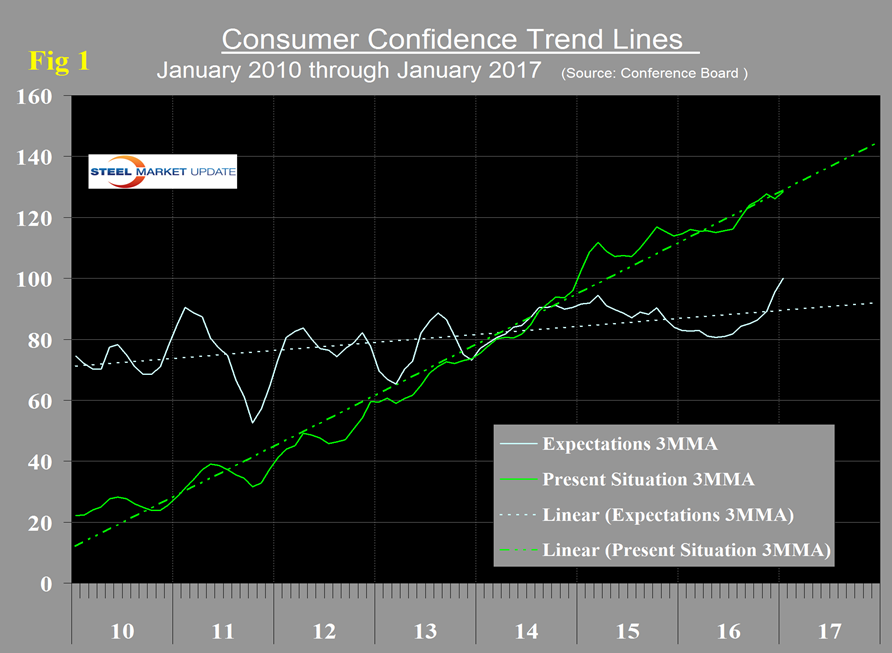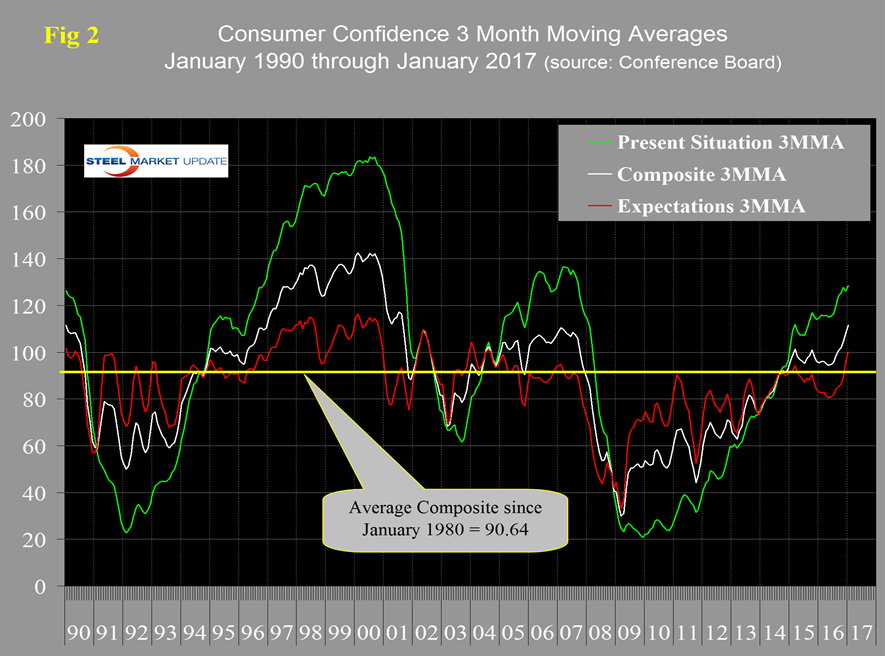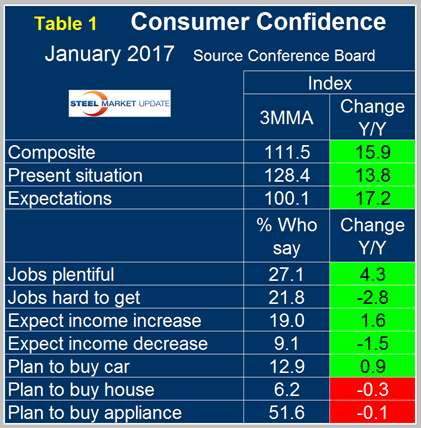Economy

Consumer Confidence 3MMA Best Since August 2001
Written by Peter Wright
January 31, 2017
The source of this data is the Conference Board with analysis by Steel Market Update. Please see the end of this piece for an explanation of the indicator.
The January report indicated a small decline from December but the three month moving average (3MMA) was the strongest since August 2001. Consumer confidence is the driver of consumer spending which is the largest component of GDP and which ultimately drives a large portion of steel consumption.
Included below is the official news release from the Conference Board.
The low point for consumer confidence last year was May with a value of 92.4, its lowest value since July 2015. In December the composite index had a value of 113.3 which fell to 111.8 in January. The 3MMA increased from 107.8 to 111.5. The 3MMA has risen for eight consecutive months from 94.4 last May. We prefer to smooth the data with a moving average because of monthly volatility which in the case of consumer confidence has been quite extreme since the beginning of last year. The composite index is made up of two sub-indexes. These are the consumer’s view of the present situation and his/her expectations for the future. The 3MMA of the present situation is exactly on its seven year trend line as expectations have surged up and through their trend line for the first time since November last year (Figure 1).
The historical pattern of the 3MMA of the composite, the view of the present situation and expectations are shown in Figure 2.
The progression of the 3MMA of the composite was positive throughout 2014 into early 2015 and then lacked direction for 15 months as expectation decreases negated the improving view of the present situation. The composite has surged in the last six months. Comparing January 2016 with January 2015 (y/y), the 3MMA of the composite was up by 15.9, the present situation was up by 13.8 and expectations were up by 17.2 (Table 1).
Our December report had Table 1 all green for the first time since June last year. This month both the intentions to buy a home and an appliance were lower than January 2016. The consumer confidence report includes data on job availability and wage expectations. It reports on the proportion of people who find that jobs are hard to get and those who believe jobs are plentiful and it measures those who expect a wage increase or a decrease. Since August 2011 both of the job availability components have steadily improved. Expectations for wage increases have not been as consistent but in this report the proportion expecting an increase rose and those expecting a decrease declined. Prior to this January report, plans to buy a home had been positive y/y in 17 of the previous 19 months. Plans to buy appliances were positive in 10 of the previous 12 months. Plans to buy a car have been positive y/y for 9 of the last 10 months.
SMU Comment: At the present rate, consumer confidence will exceed in the next few months the previous peak that occurred just before the recession. This indicator is positively correlated with personal consumption which accounts for about 2/3 of GDP. Ultimately a positive growth of GDP has a positive effect on steel consumption therefore the overall improvement in the level of consumer confidence since last May is very welcome.
The official news release from the Conference Board reads as follows and is entirely based on monthly changes. This is a highly regarded indicator which we believe needs to be examined in a longer time context to get the true picture which is why we only consider three month moving averages and focus our comments on year over year results. Because we look at time frames longer than one month, our take on the January report is considerably more positive than the official view.
The Conference Board Consumer Confidence Index Declined in January
The Conference Board Consumer Confidence Index, which had increased in December, retreated in January. The Index now stands at 111.8 (1985=100), down from 113.3 in December. The Present Situation Index increased from 123.5 to 129.7, but the Expectations Index decreased from 106.4 last month to 99.8. The cutoff date for the preliminary results in this update was January 19.
“Consumer confidence decreased in January, after reaching a 15-year high in December (Aug. 2001, 114.0),” said Lynn Franco, Director of Economic Indicators at The Conference Board. “The decline in confidence was driven solely by a less optimistic outlook for business conditions, jobs, and especially consumers’ income prospects. Consumers’ assessment of current conditions, on the other hand, improved in January. Despite the retreat in confidence, consumers remain confident that the economy will continue to expand in the coming months.”
Consumers’ appraisal of current conditions improved in January. Those saying business conditions are “good” increased slightly from 28.6 percent to 29.3 percent, while those saying business conditions are “bad” decreased from 17.8 percent to 16.1 percent. Consumers’ assessment of the labor market was also more positive than last month. The percentage of consumers stating jobs are “plentiful” rose from 26.0 percent to 27.4 percent, while those claiming jobs are “hard to get” decreased from 22.7 percent to 21.5 percent.
Consumers’ short-term outlook, which had increased considerably last month, declined in January. The percentage of consumers expecting business conditions to improve over the next six months decreased from 24.7 percent to 23.1 percent, while those expecting business conditions to worsen increased from 8.9 percent to 10.7 percent.
Consumers’ outlook for the labor market was somewhat mixed. The proportion expecting more jobs in the months ahead decreased from 21.7 percent to 19.8 percent, while those anticipating fewer jobs was virtually unchanged at 14.0 percent. The percentage of consumers expecting their incomes to increase declined from 21.5 percent to 18.0 percent, while the proportion expecting a decrease rose from 8.6 percent to 9.6 percent.
About The Conference Board
The Conference Board is a global, independent business membership and research association working in the public interest. Our mission is unique: To provide the world’s leading organizations with the practical knowledge they need to improve their performance and better serve society. The monthly Consumer Confidence Survey, based on a probability-design random sample, is conducted for The Conference Board by Nielsen, a leading global provider of information and analytics around what consumers buy and watch. The index is based on 1985 = 100. The composite value of consumer confidence combines the view of the present situation and of expectations for the next six months. The Conference Board is a non-advocacy, not-for-profit entity holding 501 (c) (3) tax-exempt status in the United States. www.conference-board.org.

Peter Wright
Read more from Peter WrightLatest in Economy

ISM: Manufacturing expansion loses steam after two months of growth
US manufacturing activity slowed in March after two straight months of expansion, according to supply executives contributing to the Institute for Supply Management (ISM)’s latest report.

Chicago Business Barometer rose to 16-month high in March
The Chicago Business Barometer increased for the third-consecutive month in March. Despite this, it still reflects contracting business conditions, as it has since December 2023.

Durable goods orders rise again in February
Transportation equipment led the increase, rising 1.5% to $98.3 billion.

Consumer confidence falls for fourth consecutive month
People remain concerned about inflation, trade policies, and tariffs.

Housing starts ticked up in February
Single-family starts last month hit a rate of 1.10 million, a month-over-month increase of 11.4%, census data shows.



